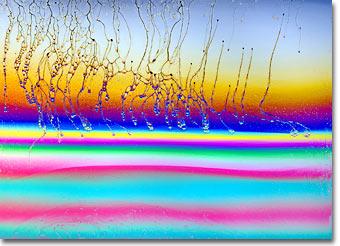Karl E. Deckart
Soap Bubble Gallery: Image Five
German photographer and artist Karl E. Deckart is known for his thorough, precise, and beautiful work both in photography through the microscope and with macro camera systems. This gallery of interference photographs made with soap films is a testament to both Deckart's skill as a photographer and his understanding of the physical phenomena that surround our everyday lives. Presented below is soap bubble image number five in small format. Click on the image to download a larger version.

|
Macrophotography of thin soap films freely suspended on a 4 x 4-inch wire frame was conducted with a Linhof large-format bellows camera system utilizing 4 x 5-inch sheet film and imaged using an apo-macro Nikon large format Nikkor-AM ED 210 mm f-5.6 lens. To prepare the soap film, equal parts of water, glycerin, and dishwasher detergent are thoroughly mixed in a container until a solution containing evenly sized micelles is achieved. A freestanding film is formed by dipping the wire frame into the solution and withdrawing carefully to maintain an even film thickness and avoid disruption of material flow across the frame rails. After suspension, the film was illuminated by a reflected light source positioned a few degrees from the camera system. The light was passed through a diffusion screen to avoid bright spots and provide an even illumination across the field. No polarizers were employed in photomacrography of soap thin films. Image ©1999 by Karl E. Deckart. All rights reserved. |
When bathed in light, transparent delicate spheres of soap bubbles shimmer with an iridescent spectrum of colors. The intricate dance of light waves upon a thin elastic membrane produces swells of color concentration in the bubbles. This phenomenon, termed interference, arises from incident light reflecting from the interior and exterior surfaces. The reflected light waves either cancel each other, or add together to produce more intense colors in a process known as interference. Some colors combine to form currents and eddies of beautiful mingling colors and are said to be in phase, while others subtract to produce dark zones. Wavelengths of light that are suitably matched to bubble membrane thickness correlate in determining surface color. However, iridescence vanishes in films that are thick, and in soapy films that are beyond a certain thickness, constructively interfering colors overlap producing white bubbles.
BACK TO THE SOAP BUBBLE GALLERY
